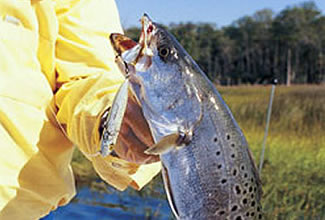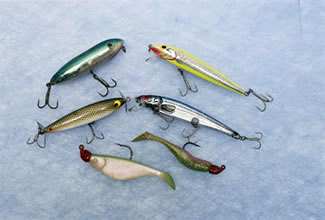May 16, 2011
By Chris Christian
Catch big trout in the maze of downtown Jacksonville waterways.

Small creeks that empty into deeper channels are prime spots to plug for gator trout. |
Big trout like to hang around docks, especially those adjacent to deep water with an old boat tied to them. I learned that many years ago and seldom pass by that kind of target without making a few casts. But I was shocked when Jim Romeka pulled up next to a 600-foot merchant vessel docked at Blount Island, and began tossing a topwater plug at a section of rock seawall off the ship's bow. From my perspective, that was carrying my tidbit of angling wisdom to extremes.
However, my opinion on the matter changed three casts later, when a 6-pound trout boiled off the rock wall and exploded on his topwater.
I suppose it did meet my dock/boat/deepwater criteria. There certainly was a dock, a “boat” of sorts, and since we were in 30 feet of water, the deep water aspect was well-addressed. The ingredients were there, just on a different scale. But the term “different” becomes normal when you're fishing around Jacksonville.
I seriously doubt there's a more diverse water body in Florida than the St. Johns River at Jacksonville. One would have to include the maze of shallow and deep spartina grass and oyster-lined tidal creeks in the Hannah Mills and Sisters Creek area, to the main ship channel from the Mayport Jetties to below Buckman Bridge. Also the shallow, oyster-laden flats around Mill Cove, the array of docks, and the Intra-coastal Waterway from Chicopit Bay to the Atlantic Boulevard Bridge. That's just about any inshore angling situation one could find.
It's an interesting area to fish, and for those chasing big trout, it can be a very rewarding one.
“When it comes to big trout,” says Romeka, “I'd put the lower St. Johns River up against any other spot in Florida, and it's more productive than all but a few.”
I'd have to concur with his assessment. Having stalked trout from Flamingo to Georgia, I can only think of a couple of spots where my chances of catching a Florida trout over eight pounds are better. A lot of that has to do with forage, as it turns out.
Redfish tournament catch statistics have shown that the St. Johns rivermouth produces the heaviest reds for their length in Florida. Why? Biologists tell me it's because of a very rich estuarine environment that puts some serious weight on redfish. (The equivalent of eating at McDonalds every day).
Jacksonville, indeed, is a much-overlooked trout fishery, and for anglers who would like to tap into that, virtually any month of the year can be productive. In fact, during one midday August trip with Romeka, I landed a 7-pound trout at noon under a searing, clear blue sky, on a topwater plug, in only three feet of water.
You're not supposed to be able to do that. But Jacksonville somehow is different.
For those who want to hit the peak seasons, however, Romeka (who's been fishing and guiding in the Jacksonville area for over 25 years) pins it down a bit more definitively.

A lure selection like this should cover just about any feeding situation. |
“Mid-February through May would be my choice for the best shot at a gator trout in this area,” he says. “There are more of them around, and they're in a serious feeding mode as the water warms. You can catch good numbers of trout and some big ones, at other times of the year. But spring is the time for trophies, and I believe every trout over 10 pounds that was ever landed in my boat was a spring fish.”
Those big trout were caught in some remarkably diverse areas. Some were in three to four feet of water off spartina grassbeds, tucked away in shallow and nameless tidal creeks. Others were right out in the main ship channels, and came from spots where deep water meets shoreline seawall.
Where to fish depends largely on the tides, and for those used to those gentle South Florida and Gulf Coast currents, the River City is quite different.

The author admires a trout that struck a topwater. |
The First Coast area, as we call it, has the largest tidal fluctuation in Florida. “Average” tides are four feet and more, and there are always two tide cycles per 24- hour period. That's a lot of water in constant motion, and tide speed can be considerable in some areas. That's why veteran anglers don't mess around with weenie trolling motors here. They want the bigger models that crank out 80 to over 100 pounds of thrust. On the full and new moons each month, and especially during winter, those tides rise and fall some six feet and more. That's when savvy trout anglers really appreciate big trolling motors.
That strong current also moves baitfish a considerable distance, with the trout close behind, and a spot that may be hot for two hours on a particular tide may be dead for the rest of the day. The tide is the key to where and what type of cover he wants to fish.
“If I could pick perfect conditions it would be a high tide at sunrise,” Romeka notes. “That puts a lot of bait in the grass, and trout will be roaming the outside edge of that grassline. That's a perfect time for a topwater plug, and the action will last for the first few hours of the falling tide as well.”
Under these conditions, Romeka is generally heading for saltgrass country. The most productive waters he's found are the Hannah Mills area, Clapboard and Sisters Creek, Mill Cove, Chicopit Bay and the stretch of the ICW between Chicopit Bay and the Atlantic Boulevard bridge. All of these areas feature shoreline grass, and numerous sections where oyster clumps lie just outside the flooded grass. That's a lot of cover to fish—but savvy anglers narrow their search to where there is visible baitfish activity. Find the bait and you.
FS

